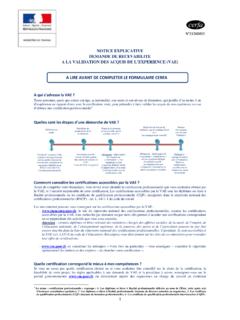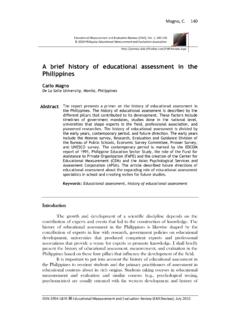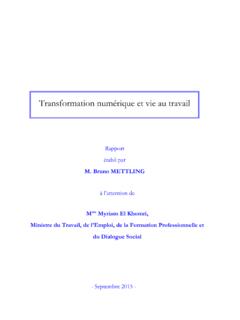Transcription of 1 Army Modernization Strategy
1 1 | Army Modernization Strategy 1 | Army Modernization Strategy Army Modernization Strategy The Army Modernization Strategy (AMS) describes how the Total Army Regular Army, National Guard, Army Reserve, and Army Civilians will transform into a multi-domain force by 2035, meet its enduring responsibility as part of the Joint Force to provide for the defense of the United States, and retain its position as the globally dominant land power. The 2018 Army Modernization Strategy Report to Congress introduced the Army s six materiel Modernization priorities to make Soldiers and units more lethal to deploy, fight, and win our Nation s wars.
2 This 2019 AMS expands the Army s approach beyond those six priorities, outlining a more holistic approach to Modernization while maintaining continuity of priorities. Modernization is a continuous process requiring collaboration across the entire Army. Therefore, while this AMS outlines an end state for the future Army in 2035, Army Modernization will remain ongoing as we must continue to test and refine operating concepts, draw on emerging technologies, and anticipate changes in the operating environment. Army Modernization Framework The primary end state of the 2019 AMS, nested with the 2018 Army Strategy , is a modernized Army capable of conducting Multi-Domain Operations (MDO) as part of an integrated Joint Force in a single theater by 2028, and ready to conduct MDO across an array of scenarios in multiple theaters by 2035.
3 The MDO concept describes how the Army will support the Joint Force in the rapid and continuous integration of all domains of warfare land, sea, air, space, and cyberspace to deter and prevail as we compete short of conflict, and fight and win if deterrence fails. To achieve this end state by 2035, the Army will modernize how we fight, what we fight with, and who we are. This approach integrates the elements of doctrine, organizations, training, materiel, leader development and education, personnel, facilities, and policy (DOTMLPF-P) within the Army, with other Joint Force elements, and alongside allies and partners.
4 How we fight is the realm of concepts, doctrine, organizations, and training. What we fight with is characterized by materiel development and procurement, guided by the Army s six materiel Modernization priorities. Who we are encompasses leader development, education, and 21st century talent management. Modernizing across each effort in a synchronized way will ensure the Army has well-trained Soldiers, organized into effective warfighting formations with modern weapon systems and sufficient capacity to win in any conflict, on any battlefield, anywhere in the world. These elements are interdependent and require corresponding updates to global force posture, facilities, and policies to ensure the Army s Modernization efforts remain synchronized over time and with the rest of the Joint Force.
5 The Army s reform efforts have reduced bureaucracy and realigned funding towards our top priorities to enable these Modernization efforts. The Army established Army Futures Command (AFC) to realign elements of the Modernization enterprise and bring unity of effort to the future force development process. For example, Cross-Functional Teams (CFT), subordinate elements of AFC, align requirements developers with acquisition experts and representatives from the testing, logistics, science and technology, and other communities, dramatically reducing the time span from identification of a capability gap to prototype testing and operational experimentation.
6 The Army has also demonstrated its commitment to fully resourcing priority Modernization 2 | Army Modernization Strategy efforts. The Army has already realigned over $33B in the FY2020-2024 Program Objective Memorandum (POM) to ensure adequate funding for CFT signature efforts. Together, the realignment of the Modernization enterprise and prioritization of funding, combined with feedback from the operating force, are the means by which we will execute the AMS. Figure 1. The Army Modernization Strategy Framework The Strategic Environment: Renewed Great Power Competition in the Information Age The 2018 National Defense Strategy (NDS) states that we must prioritize long-term strategic competition with China and Russia while deterring regional adversaries and sustaining irregular warfare competency.
7 Political, economic, social, and technological changes will continue to create challenges and opportunities for the Army as we maintain our land dominance. Future warfare will only expand in geographic scale, domains, and types of actors while decision cycles and reaction times compress. Russia is the Army s current pacing threat. It is our nation s most capable nuclear-armed threat in the near term. The Russian military has made considerable progress in reviving its capabilities to wage modern war, and it has capitalized on operational lessons learned from Crimea, eastern Ukraine, and Syria. Russia has unveiled new capabilities such as the use of proxies, unmanned 3 | Army Modernization Strategy and robotic systems, precision strike weapons, and sophisticated cyber capabilities.
8 It continues to develop other capabilities, including airborne forces, and chemical and biological weapons. China is also rapidly modernizing its armed forces, and is projected to surpass Russia in the mid-to-long-term as our most capable threat. China is one of the world s leaders in technological research and development. China is now conducting research into a wide range of militarily relevant technology including Artificial Intelligence (AI), hypersonics, robotics, swarming, advanced materials, bio-engineering, quantum information sciences, space technologies, biometrics, and other areas. Their focus on anti-access and area denial (A2/AD) capabilities includes naval forces, cruise and ballistic missiles, and a formidable proficiency in cyber and space operations.
9 The United States faces these challenges alongside numerous allies and partners. Russia and China often compete with non-military instruments of national power, and many countries are increasingly concerned by their revisionist actions. The Army must continue to work closely with our longstanding allies and partners, and attract new partners that offer unique perspectives and capabilities, as we pursue this Modernization approach. Alliances strengthen our military and political partnerships, signal that strength to deter potential aggression, increase interoperability and operational effectiveness, position forces and capabilities for future challenges, and refine our operational concepts and tactical practices.
10 Assumptions This Strategy is based on four key assumptions. Changes in any of these assumptions could affect the Army s strategic approach to Modernization . The Army s budget will remain flat, resulting in reduced spending power over time. Demand for Army forces will remain relatively constant while we execute this Strategy . Research and development will mature in time to make significant improvements in Army capabilities by 2035. Adversary Modernization programs will stay on their currently estimated trajectories in terms of capability levels and timelines. The Strategic Approach: Maintaining our Priorities and Generating Momentum The AMS supports the priorities outlined in the 2018 Army Strategy , which will shift our top focus to Modernization by FY2022 while sustaining readiness for current operations.

















